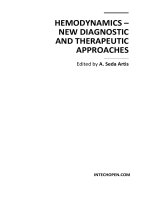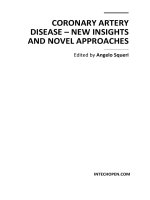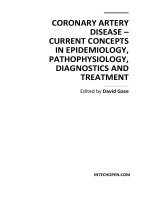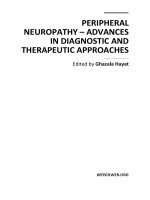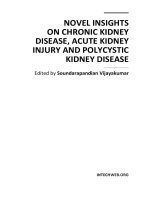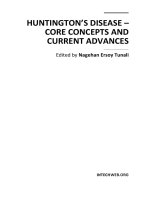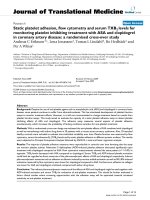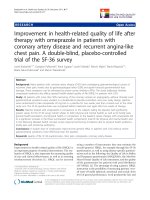Coronary Artery Disease – New Insights and Novel Approaches Edited by Angelo Squeri pdf
Bạn đang xem bản rút gọn của tài liệu. Xem và tải ngay bản đầy đủ của tài liệu tại đây (5.62 MB, 270 trang )
CORONARY ARTERY
DISEASE – NEW INSIGHTS
AND NOVEL APPROACHES
Edited by Angelo Squeri
Coronary Artery Disease – New Insights and Novel Approaches
Edited by Angelo Squeri
Published by InTech
Janeza Trdine 9, 51000 Rijeka, Croatia
Copyright © 2012 InTech
All chapters are Open Access distributed under the Creative Commons Attribution 3.0
license, which allows users to download, copy and build upon published articles even for
commercial purposes, as long as the author and publisher are properly credited, which
ensures maximum dissemination and a wider impact of our publications. After this work
has been published by InTech, authors have the right to republish it, in whole or part, in
any publication of which they are the author, and to make other personal use of the
work. Any republication, referencing or personal use of the work must explicitly identify
the original source.
As for readers, this license allows users to download, copy and build upon published
chapters even for commercial purposes, as long as the author and publisher are properly
credited, which ensures maximum dissemination and a wider impact of our publications.
Notice
Statements and opinions expressed in the chapters are these of the individual contributors
and not necessarily those of the editors or publisher. No responsibility is accepted for the
accuracy of information contained in the published chapters. The publisher assumes no
responsibility for any damage or injury to persons or property arising out of the use of any
materials, instructions, methods or ideas contained in the book.
Publishing Process Manager Vedran Greblo
Technical Editor Teodora Smiljanic
Cover Designer InTech Design Team
First published March, 2012
Printed in Croatia
A free online edition of this book is available at www.intechopen.com
Additional hard copies can be obtained from
Coronary Artery Disease – New Insights and Novel Approaches, Edited by Angelo Squeri
p. cm.
ISBN 978-953-51-0344-8
Contents
Preface IX
Part 1 Pathogenesis 1
Chapter 1 Gene Polymorphism and Coronary Heart Disease 3
Nduna Dzimiri
Chapter 2 Lipoprotein(a) Oxidation,
Autoimmune and Atherosclerosis 49
Jun-Jun Wang
Chapter 3 ICAM-1: Contribution to Vascular
Inflammation and Early Atherosclerosis 65
Sabine I. Wolf and Charlotte Lawson
Chapter 4 Molecular and Cellular Aspects of Atherosclerosis:
Emerging Roles of TRPC Channels 91
Guillermo Vazquez, Kathryn Smedlund,
Jean-Yves K. Tano and Robert Lee
Chapter 5 Hypoxia-Regulated
Pro- and Anti-Angiogenesis in the Heart 103
Angela Messmer-Blust and Jian Li
Chapter 6 Paraoxonase 1 (PON1) Activity,
Polymorphisms and Coronary Artery Disease 115
Nidhi Gupta, Kiran Dip Gill and Surjit Singh
Part 2 Acute Coronary Syndrome 137
Chapter 7 Acute Coronary Syndrome:
Pathological Findings by Means of Electron
Microscopy, Advance Imaging in Cardiology 139
Mohaddeseh Behjati and Iman Moradi
VI Contents
Chapter 8 Shortened Activated Partial Thromboplastin Time (APTT):
A Simple but Important Marker of Hypercoagulable
State During Acute Coronary Event 157
Wan Zaidah Abdullah
Part 3 Cardiovascular Prevention 167
Chapter 9 Individualized Cardiovascular Risk Assessment 169
Eva Szabóová
Chapter 10 Metabolomics in Cardiovascular Disease:
Towards Clinical Application 207
Ignasi Barba and David Garcia-Dorado
Chapter 11 Novel Regulators of Low-Density Lipoprotein Receptor
and Circulating LDL-C for the Prevention and Treatment
of Coronary Artery Disease 225
Guoqing Cao, Robert J. Konrad, Mark C. Kowala and Jian Wang
Chapter 12 Serum Choline Plasmalogen
is a Reliable Biomarker for Atherogenic Status 243
Ryouta Maeba
and Hiroshi Hara
Preface
Coronary Artery disease is one of the leading causes of death in industrialized
countries and is responsible for one out of every six deaths in the United States.
Remarkably, coronary artery disease is also largely preventable. The pathogenesis is
complex and involves many different pathways that are only partially understood.
Recently, the morbidity and mortality of ischaemic heart disease have substantially
improved because of progress in therapeutic strategies, represented by the dramatic
evolution of percutaneous coronary intervention. The biggest challenge in the next
years is, however, to reduce the incidence of coronary artery disease worldwide.
A complete knowledge of the mechanisms responsible for the development of
ischaemic heart disease is an essential prerequisite to a better management of this
pathology improving prevention and therapy.
This monograph deals with the pathophysiology of atherosclerosis with emphasis on
epigenetics, metabolomics, inflammation, molecular and cellular mechanisms
involved in cardiovascular disease development.
This book has been written with the intention of providing new concepts about
coronary artery disease pathogenesis that may link various aspects of the disease,
going beyond the traditional risk factors.
Angelo Squeri, MD
Maria Cecilia Hospital – GVM Care & Research
Italy
Part 1
Pathogenesis
1
Gene Polymorphism and
Coronary Heart Disease
Nduna Dzimiri
King Faisal Specialist Hospital and Research Centre
Saudi Arabia
1. Introduction
Like all other organs and tissues in a mammalian body, the heart muscle requires oxygen-
rich blood in order to function, while oxygen-depleted blood needs to be transported away
from organs. The first requirement is accomplished through the coronary artery networks
which serve to furnish blood supply to the cardiac muscle, while the second is attained
through a network of blood veins.
Fig. 1. The coronary artery network of the heart.
Coronary Artery Disease – New Insights and Novel Approaches
4
The coronary artery system consists of two main arteries, the left and right arteries, and
their marginal arterial network. Anatomically, the left main coronary artery (LMCA)
consists of the left anterior descending artery and the circumflex branch that supplies
blood to the left ventricle and atrium (Figure 1). Additional arteries branching off the
LMCA furnish the left heart side muscles with blood. These include the circumvent
artery, which branches off the left coronary artery and encircles the muscle to supply
blood to the lateral side and back of the heart, and the left anterior descending artery,
which supplies the blood to the front of the left side of the heart. The right coronary
artery, on the other hand, branches into the right posterior descending and acute marginal
arteries to supply blood to the right ventricle, right atrium sinoatrial node (cluster of cells
in the right atrial wall that regulate the heart’s rhythmic rate) and the atrioventricular
node. Other smaller branches of the coronary arteries include the acute marginal,
posterior descending, obtuse marginal, septal perforator and the diagonals, which
provide the surrounding network with blood supply.
2. What causes coronary artery disease?
Since coronary arteries deliver blood to the heart muscle, disease can have serious
implications by reducing the flow of oxygen and nutrients to the heart, which in turn may
lead to a heart attack and possibly death. Besides, the susceptibility and function of
the vessel wall are dependent on the balance of several counteracting forces, i.e.,
vasoconstricting versus vasodilating, growth-promoting versus growth-inhibiting and
proapoptotic versus antiapoptotic functions. While these factors are tightly balanced in a
normal healthy vessel, under pathophysiologic conditions this balance is upset resulting in
the development of vascular hypertrophy and the generation of proatherogenic vascular
lesions, thereby triggering the initiation and progression of coronary artery disease (CAD)
or atherosclerosis (as it is often called). CAD is a complex disorder, which culminates in the
coronary bed system failing to furnish adequate blood supply to the heart. The disease has
no clear etiology and manifests itself both in the young (early onset) as in familial cases as
well as in adults (late onset).
One major culprit for CAD is a perturbation in lipid metabolism. A lipid is any fatty
material or fat-like substance, e.g. normal body fat, cholesterol (i.e. high density and low
density lipoproteins), other steroids, and substances containing fats, such as
phospholipids, glycolipids and lipoproteins. Specifically, cholesterol (Chol) constitutes
one of the most clinically important lipid substances, and alterations in the balance
between its synthesis and the metabolism of its by-products is a major source of
cardiovascular complications. Together with its metabolites, Chol plays a variety of
essential roles in living systems. In fact, virtually all animal cells require Chol, which they
acquire through synthesis or uptake, but only the liver can degrade it. Failure of metabolic
pathways to break these substances down as required, or by the system to maintain the
right balance, will lead to their increased levels, and therefore predispose an individual to
acquiring CAD. Circulating lipoproteins are regulated at various levels, ranging from
Chol synthesis, transport and metabolism. Chol biosynthesis comprises the condensation
of acetyl-CoA and acetoacetyl-CoA into 3-hydroxy-3-methylglutaryl-coenzyme A (HMG-
CoA), which in turn is reduced to mevalonate by the HMG-CoA reductase (HMGCR)
followed by oxidoreduction and decarboxylation intermediate steps leading to the
Gene Polymorphism and Coronary Heart Disease
5
conversion of lanosterol to Chol. It is regulated through feedback inhibition by sterols and
non-sterol metabolites derived from mevalonate. The HMGCR, an integral glycoprotein of
endoplasmic reticulum membranes that remains in the endoplasmic reticulum after
synthesis and glycosylation, is the rate-limiting enzyme in Chol biosynthesis in
vertebrates.
The maintenance of Chol homeostasis encompasses diverse metabolic pathways linked to
its transportation, metabolism and its metabolic by-products. Since Chol is insoluble in
blood, it is transported in the circulatory system within a large range of lipoproteins in
blood. Thereby, its transportation to peripheral tissues is accomplished by the
lipoproteins, chylomicrons, very low density lipoproteins (VLDLs) and low density
lipoproteins (LDLs), while high-density lipoprotein (HDL) particles transport it back to
the liver for excretion. Functionally, LDL is a metabolic end-product of the triglyceride
(TG)-rich lipoproteins (i.e. VDLDs). Lipoprotein metabolism constitutes a major
component in the regulation of Chol homeostasis. Systems regulating Chol levels include
the LDL receptor (LDLR) pathway and its ligand the apolipoprotein B100 (Apo B), which
are involved in the maintenance of its homeostasis in the body by regulating the hepatic
catabolism of LDL-Cholesterol (LDL-C), and the proprotein convertase subtilisin/kexin
type 9 (PCSK9). The serine protease PCSK9 is a member of the proteinase K subfamily of
subtilases that also affects plasma LDL-C levels by altering LDLR levels via a post-
transcriptional mechanism
1
, and cellular Chol metabolism by regulating both LDLR and
circulating Apo B-containing lipoprotein levels in LDLR-dependent and -independent
fashions
2-4
. It regulates LDL-C levels apparently both intracellularly and by behaving as a
secreted protein that can be internalized by binding the LDLR. In the liver, it controls the
plasma LDL-C level by post-transcriptionally downregulating the LDLR through binding
to the epidermal growth factor-like repeat A (EGF-A) domain of the LDLR
5
,
independently of its catalytic activity. The LDLR regulates the plasma LDL-C
concentration by internalizing Apo B and Apo E-containing lipoproteins via receptor-
mediated endocytosis. Apo B is a large, amphipathic glycoprotein that plays a central role
in human lipoprotein metabolism. Two forms of Apo B are produced from the Apo B gene
through a unique posttranscriptional editing process: Apo B-48, which is required for
chylomicron production in the small intestine, and Apo B required for VLDL production
in the liver. In addition to being the essential structural component of VLDL, Apo B is the
ligand for LDLR-mediated endocytosis of LDL particles. Lipoprotein (a) [Lp(a)] contains
an LDL-like moiety, in which the Apo B component is covalently linked to the unique
glycoprotein apolipoprotein(a) (Apo A). Apo A-I is essential for the formation of HDL
particles. Apo A-I-containing HDL particles play a primary role in Chol efflux from
membranes, at least partly, through interactions with the adenosine triphosphate-binding
cassette transporter A1 (ABCA1). The ABCA1 regulates the rate-controlling step in the
removal of cellular Chol, i.e. the efflux of cellular Chol and phospholipids to an
apolipoprotein acceptor. Apo A is composed of repeated loop-shaped units called
kringles, the sequences of which are highly similar to a kringle motif present in the
fibrinolytic proenzyme plasminogen. Variability in the number of repeated kringle units
in the Apo A molecule gives rise to different-sized Lp(a) isoforms in the population.
Based on the similarity of Lp(a) to both LDL and plasminogen, its function is thought to
represent a link between atherosclerosis and thrombosis. However, determination of the
function of Lp(a) in vivo remains elusive. Mechanistically, elevated Lp(a) levels may
Coronary Artery Disease – New Insights and Novel Approaches
6
either induce a prothrombotic/anti-fibrinolytic effect as Apo A resembles both
plasminogen and plasmin but has no fibrinolytic activity, and/or may accelerate
atherosclerosis because, like LDL, the Lp(a) particle is Chol-rich. Apolipoprotein E (apo E)
is also a constituent of various lipoproteins and plays an important role in the transport of
Chol and other lipids among cells of various tissues.
Apart from lipoproteins, circulating VLDLs serve as vehicles for transporting lipids to
peripheral tissues for energy homeostasis. VLDLs are TG-rich particles synthesized in
hepatocytes and secreted from the liver in a pathway that is tightly regulated by insulin.
Hepatic VLDL production is stimulated in response to reduced insulin action, resulting in
increased release of VLDL into the blood under fasting conditions, while it is suppressed in
response to increased insulin release after meals. This effect is critical for preventing
prolonged excursion of postprandial plasma lipid profiles in normal individuals. HDL
particles are key players in the reverse Chol transport by shuttling it from peripheral cells
(e.g. macrophages) to the liver or other tissues. This complex process is thought to represent
the basis for the antiatherogenic properties of HDL particles. Accordingly, the particles
mediate the uptake of peripheral Chol and return it to the liver for bile acid secretion
through exchange of core lipids with other lipoproteins or selective uptake by specific
receptors. These particles vary in size and density, mainly because of differences in the
number of apolipoprotein (apo) particles and the amount of Chol ester in the core of HDL
molecule.
The majority of lipoprotein disorders result from a combination of polygenic
predisposition and poor lifestyle habits, including physical inactivity, increased visceral
adipose tissue, increased caloric intake, and cigarette smoking. Plasma elevation of LDL-
C, VLDL and Lp(a), as well as reduced HDL-C levels are predisposing factors for CAD.
The amount of Chol transported is inversely correlated with the risk for CAD. Reduced
circulating levels of HDL-C are a frequent lipoprotein disorder in CAD patients and can
be caused by either genetic and/or environmental factors (sedentary lifestyle, diabetes
mellitus, smoking, obesity or a diet enriched in carbohydrates. Lp(a) is a unique
lipoprotein particle consisting of a moiety identical to LDL to which the glycoprotein
Apo(a) that is homologous to plasminogen is covalently attached. These features
have suggested that Lp(a) may contribute to both proatherogenic and
prothrombotic/antifibrinolytic processes, which constitute a risk factor for premature
cardiovascular disease. Among others, the association between elevated Lp(a) levels and
increased CAD risk, indicates that elevated Lp(a), like elevated LDL-C, is causally related
to premature CAD. However, although Lp(a) has been shown to accumulate in
atherosclerotic lesions, its contribution to the development of atheromas is unclear. This
uncertainty is related in part to the structural complexity of the Apo A component of
Lp(a) (particularly apo A isoform size heterogeneity), which also poses a challenge for
standardization of the measurement of Lp(a) in plasma. However, while LDL and Lp(a)
are now believed to be atherogenic, the role of VLDL as an independent risk factor
remains controversial. On the other hand, the HDL is the only lipoprotein that has been
established as antiatherogenic, thought to reduce CAD risk by mediating Chol efflux from
the periphery by way of transportation to the liver for excretion.
Hepatic lipase (HL), a member of the lipase superfamily, is a lipolytic enzyme that is
produced primarily by hepatocytes, where it is secreted and bound to the hepatocyte
Gene Polymorphism and Coronary Heart Disease
7
surface and readily released by heparin. It is homologous to LPL and pancreatic lipase
and hydrolyzes TGs and phospholipids in all lipoproteins, but is predominant in the
conversion of IDL to LDL and the conversion of post-prandial TG-rich HDL into the post
absorptive TG-poor HDL. Thus, the enzyme contributes to the regulation of plasma TG
levels by facilitating its exudation from the VLDL pool, in a fashion that is governed by
the composition and quality of HDL particles. It is thought that HL directly couples HDL
lipid metabolism to tissue/cellular lipid metabolism
43
. Accordingly, hepatic lipase HDL
regulates the release of HL from the liver and HDL, controls HL transport and activation
in the circulation in a fashion that is regulated by factors that release it from the liver and
activate it in the bloodstream. Therefore, alterations in HDL-apolipoprotein composition
can disturb HL function by inhibiting the release and activation of the enzyme, thereby
affecting plasma TG levels and CAD risk. It has been suggested that the HL pathway
potentially provides the hepatocyte with a mechanism for the uptake of a subset of
phospholipids enriched in unsaturated fatty acids and may allow the uptake of
cholesteryl ester, free Chol, and phospholipid without catabolism of HDL
apolipoproteins
43
. HL plays a secondary role in the clearance of chylomicron remnants by
the liver
43
. Consistent with IDL being a substrate for HL, the human post-heparin HL
activity is inversely correlated with IDL-C concentration only in subjects with a
hyperlipidaemia involving VLDL. HDL-C has been reported to be inversely correlated to
HL activity, leading to the suggestion that lowering HL would increase its levels.
Common hormonal factors, such as estrogen, have also been shown to upregulate Apo A
and HDL-C and lower HL. Hence this relationship may not be specific. However, an
increase in HDL-C, Apo A, or HDL –triglycerides has been observed in severe deficiency
of HL. Apart from heparin, HL also binds o the LDLR-related protein. This has led to the
notion that enzymatically inactive HL may play a role in hepatic lipoprotein uptake,
forming a bridge by binding to the lipoprotein and to the cell surface, raising the
possibility that production and secretion of mutant inactive HL could promote clearance
of VLDL remnants.
One of the important proteins involved in lipoprotein metabolism is the CETP. Plasma
CETP facilitates the transfer of cholesteryl ester from HDL to Apo B-containing lipoproteins
by catalyzing the transfer of insoluble esters in the reverse transport of Chol. Thus, CETP is
involved in maintaining the balance between the LDL-C, ("bad" Chol) and HDL-C ("good"
Chol), which is a risk factor for hyperlipidaemia. Since CETP regulates the plasma levels of
HDL-C and the size of HDL particles, it is considered to be a key protein in reverse Chol
transport, a protective system against atherosclerosis. In mediating the transfer of
cholesteryl esters from antiatherogenic HDL to proatherogenic apolipoprotein apo-B-
containing lipoprotein particles (including VLDL, VLDL remnants, IDL, and LDL), the
CETP plays a critical role not only in the RCT pathway but also in the intravascular
remodeling and recycling of HDL particles
6,7
.
In mammalian cells, Chol homeostasis is controlled primarily by regulated cleavage of
membrane-bound transcription factors, the sterol regulatory element binding proteins
(SREBPs)
8-10
and their cleavage-activating protein (SCAP)
11,12
. The SREBPs activate specific
genes involved in Chol synthesis, LDL endocytosis, fatty acid synthesis and glucose
metabolism, providing a link between lipid and carbohydrate metabolism
13
. All three
SREBP isoforms SREBP-1a, SREBP-1c and SREBP-2 (encoded by two genes) that are
Coronary Artery Disease – New Insights and Novel Approaches
8
synthesized as 125 kDa precursor proteins localized to the endoplasmic reticulum
14
, and
play a central role in energy homeostasis by promoting glycolysis, lipogenesis and
adipogenesis
15-19
. Functionally, SREBP-2 gene activation leads to enhanced Chol uptake and
biosynthesis, while SREBP-1 is primarily involved in fatty acid and glucose metabolism
20-22
.
Mechanistically, it is thought that when cells are deprived of Chol, SREBPs are cleaved by
two proteolytic steps. First, the SREBP precursor is transported to the Golgi by the
chaperone protein SCAP and cleaved via two proteases to release the mature,
transcriptionally active 68 kDa amino terminal domain
11,12
. This domain is then released
from the endoplasmic reticulum membrane and transported into the nucleus, where it binds
to specific nucleotide sequences in the promoters of the LDLR and other genes regulating
Chol and TG homeostasis
10
.
While disorders of Chol metabolism and related lipoproteins occupy a pivotal position in
events leading to CAD, other important contributors include those that regulate the
viability of blood vessels affecting vascular function leading to the formation of plaques.
This is particularly true for coronary arteries, for example, in which an imbalance in a
number of these processes triggers a proatherogenic state initiating the progression of
atherosclerosis. Several disease pathways associated with regulation of blood pressure
and glucose metabolism are involved in intricate ways. The metabolic syndrome poses a
major public health problem by predisposing individuals to CAD and stroke, the leading
causes of mortality in developed countries. Its impact on the risk of atherosclerotic
cardiovascular disease is greater than that of any of its individual components.
Frequently, many of these metabolic manifestations, precede the development of overt
diabetes by many years
23
. This syndrome is manifest clinically by such cardiovascular risk
factors as hypertension, dyslipidaemic, and coagulation abnormalities. This abnormal
metabolic milieu contributes to the high prevalence of macrovascular complications
including CAD as well as more generalized atherosclerosis. It is frequently seen in obese
individuals, and characterized by glucose intolerance, hyperinsulinemia, a characteristic
dyslipidaemic (high TGs; low HDL-C, and small, dense LDL-C), obesity, upper-body fat
distribution, hypertension, increased prothrombotic and antifibrinolytic factors, and
therefore an increased risk of CAD
23
. However, while the conventional risk factors,
insulin resistance parameters, and metabolic syndrome are important in predicting CAD
risk, in some population environmental factors may be determinant in the ultimate
manifestation of the disease.
Apart from the PPARs, the Forkhead transcription factor (Foxo1) is also believed to play an
essential role in controlling insulin-dependent regulation of microsomal TG transfer protein
(MTP) and apolipoprotein C-III (Apo C-III), two key components that catalyze the rate-
limiting steps in the production and clearance of triglyceride-rich lipoproteins
24,25
. Under
physiological conditions, Foxo1 activity is inhibited by insulin, while under insulin resistant
conditions Foxo1 becomes uncontrolled, contributing to its hyperactivity in the liver
24
. This
effect contributes to hepatic overproduction of VLDL and impaired catabolism of
triglyceride-rich particles, accounting for the pathogenesis of hypertriglyceridemia. Thus,
augmented Foxo1 activity in insulin resistant livers promotes hepatic VLDL overproduction
and predisposes to the development of hypertriglyceridemia
25
, offering a possible route for
this manifestation.
Gene Polymorphism and Coronary Heart Disease
9
As such the contributions of the individual disease pathways such as diabetes or
hypertension may manifest themselves independently or in combination with other
disorders, leading to other complications with added risk as is the case with the metabolic
syndrome. Among these, type 2 diabetes mellitus (T2DM) constitutes probably the most
important risk disease for CAD. In contrast to type 1 diabetes mellitus, the type 2
endocrinopathy is clustered in minority populations and has both strong genetic and
environmental components that influence its manifestation. This disease is a heterogeneous
disorder and patients are often characterized by features of the insulin resistance syndrome,
also referred to as the metabolic syndrome. This syndrome is defined as a cluster of
interrelated common clinical disorders, including obesity, insulin resistance, glucose
intolerance, hypertension, and dyslipidaemic (hypertriglyceridaemia and low HDL-C
levels), exhibiting rising incidence to epidemic levels in the developed world. Among
others, insulin has important vascular actions to stimulate production of nitric oxide from
endothelium. This leads to capillary recruitment, vasodilatation, increased blood flow, and
subsequent augmentation of glucose disposal in classical insulin target tissues, such as the
skeletal muscle. Individuals displaying three of the features of insulin resistance (elevated
plasma insulin and apolipoprotein B concentrations and small, dense LDL particles) show a
remarkable increase in CAD risk and the increased risk associated with having small, dense
LDL particles may be modulated to a significant extent by the presence/absence of insulin
resistance, abdominal obesity and increased LDL particle concentration
26
. They influence
risk for CAD through promoting endothelial dysfunction and enhanced production of
procoagulants by endothelial cells
27
.
Systems regulating the coagulation mechanisms also have their fair share of disease
pathways leading to CAD. To begin with, blood platelets play a crucial role in
physiological haemostasis and in the pathology of prothrombotic states, including
atherosclerosis. Platelets are anucleate cells with no DNA. The differentiation of their
precursor, the megakaryocyte, is characterized by nuclear polyploidization through a
process called endomitosis. Changes in the megakaryocyte-platelet-haemostasis axis may
precede acute thrombotic events. Thereby, the changes in megakaryocyte ploidy
distribution may be associated with the production of large platelets. Large platelets are
denser and more active haemostatically. Mean platelet volume, an important biological
variable determinant of platelet reactivity, is increased in patients after MI and is a
predictor of a further ischaemic event and death following MI
28
. Apart from platelets,
changes also in the parental megakaryocyte are associated with chronic and acute
vascular events
29
. The regulation of megakaryocytopoiesis depends on several
haematopoietic factors such as thrombopoietin. In T2DM, platelet abnormalities,
including altered adhesion and aggregation, render the cells hypersensitive to agonists.
Besides, disturbed carbohydrate and lipid metabolism may lead to physicochemical
changes in cell membrane dynamics, and consequently altered exposure of surface
membrane receptors. These manifestations, together with increased fibrinogen binding,
prostanoid metabolism, phosphoinositide turnover and calcium mobilization often
present in diabetic patients, contribute to enhanced risk of small vessel occlusions and
accelerated development of atherothrombotic disease of coronary, cerebral and other
vessels in diabetes. The disease has emerged as an important condition of older patients in
Coronary Artery Disease – New Insights and Novel Approaches
10
which both microvascular and macrovascular complications are a common cause of
morbidity and mortality. Microvascular complications have only been recently recognized
as an important and frequent complication of T2DM
30
.
Additionally, environmental factors, such as food consumption, constitute important
components regulating pathways to complex diseases such as CAD and cancer. Dietary
Chol absorption, endogenous Chol synthesis and biliary Chol excretion regulate whole body
Chol balance as a result of biotransformation into bile acids or direct Chol excretion. Nuclear
hormone receptors, such as the liver X, farnesoid X and retinoid X receptors, regulate the
absorption of dietary sterols by modulating the transcription of several genes involved in
Chol metabolism
31
. The ABC proteins transport dietary Chol from enterocytes back to the
intestinal lumen, thus limiting the amount of absorbed Chol. By means of the same
mechanism, ABC transporters also provide an efficient barrier against the absorption of
plant sterols
31
, which may vary among different ethnic populations. For example, it appears
that some ethnic groups are at higher risk than others for the development of obesity and
obesity-related non-communicable diseases, including insulin resistance, the metabolic
syndrome, T2DM and CAD. Put together therefore, because of the various interactive
factors regulating the functionality of coronary vascular beds, many risk factors may
contribute to an individual acquiring the disease.
2.1 Coronary artery disease manifestation in the adult
These risk factors for CAD can be classified into those that regulate the levels of circulating
lipoproteins, and those that regulate the susceptibility of arterial walls. Factors regulating
lipoprotein levels include high circulating Chol and saturated fats in diet, obesity and
emotional and neurogenic factors and those that regulate arterial susceptibility are insulin
resistance, diabetes, hypertension, smoking and age (Figure 2). All these factors contribute
to the pathways leading to atherosclerosis, oft in combination with environmental factors.
Apart from the fact that most of the predisposing diseases are themselves complex ailments,
combinations of some of these disorders can cluster to induce other forms of maladies, such
as the metabolic syndrome, which in themselves constitute an added risk for coronary
disease.
For almost all of these disease pathways, their impact on CAD manifestation can be
classified as major or minor, depending on their assessed contribution (Figure 2). For
example, in the regulation of blood pressure homeostasis insulin-resistant diabetes mellitus
and essential hypertension are among the primary culprits, while angiotensin converting
enzyme (ACE) and angiotensin 1 make up secondary causative factors. Furthermore, a great
majority of these risk factors (e.g. hypertension, diabetes, hyperlipidaemia) are themselves
complex disorders underlying a variety of etiologies. In essence therefore, CAD is shaped by
a whole spectrum of phenotypic expression evolving through various events that lead to the
formation and progression of atherosclerotic plaque in the inner lining of an artery causing
it to narrow or become blocked and finally exude circulatory complications. The ultimate
disease manifestation is an expression of the shift in the balance of interactions among
factors influencing various aspects of coronary artery function and structure with prevalent
genetic factors.
Gene Polymorphism and Coronary Heart Disease
11
Fig. 2. The risk factors contributing to coronary artery disease pathways. The pathways may
lead to either an increase in in circulating lipoproteins, influence susceptibility of the vessel
walls or both components of atherosclerotic plaque formation.
Coronary Artery Disease – New Insights and Novel Approaches
12
2.1.1 Lipid metabolism and manifestation of coronary artery disease
As stated above, defects in lipid metabolic pathways, leading to increased circulating Chol
levels constitutes the major underlying cause of CAD. Hyperlipidaemia, also sometimes
referred to as hyperlipoproteinemia or dyslipidaemia, is the condition in which the blood
lipid levels are too high, often leading to various cardiovascular disorders, particularly
CAD. These disorders exist as hypercholesterolaemia, which is characterized by increased
LDL levels, hypertriglyceridaemia characterized by increased chylomicrons or VLDL levels
or combined disease manifest as increased LDL and VLDL, or VLDL and chylomicrons.
Affected individuals may also have hypercholesterolaemia or chylomicron abnormalities of
VLDL origin, with normal LDL-C levels, which is also defined as hyperlipoproteinemia.
Six subtypes of hyperlipoproteinemia types (I, II, III, IV, V and unclassified forms) have
been characterized to date. Type I (also known as Buerger-Gruetz syndrome, primary
hyperlipoproteinemia, or familial hyperchylomicronemia) is a very rare form due to a
deficiency of lipoprotein lipase (LPL) or altered apolipoprotein C2. It results in elevated
chylomicrons, the particles that transfer fatty acids from the digestive tract to the liver,
exhibiting a prevalence of 0.1% of the population. Hyperlipoproteinemia type II, by far the
most common form, is further classified into type IIa and type IIb, depending mainly on
whether there is elevation in the TG level in addition to LDL-C. Thereby type IIa is known
as familial hypercholesterolaemia. This form may be sporadic (due to dietary factors),
polygenic, or truly familial as a result of a mutation either in the LDLR gene on chromosome
19 (0.2% of the population) or the Apo B gene (0.2%). In type IIb, the high VLDL levels are
due to overproduction of substrates, including TGs, acetyl CoA, and an increase in Apo B
synthesis. They may also be caused by the decreased clearance of LDL, with a prevalence of
10% in the population. These include (a) familial combined hyperlipoproteinemia (FCH)
and (b) secondary combined hyperlipoproteinemia (usually in the context of metabolic
syndrome, for which it is a diagnostic criterion). Hyperlipoproteinemia type III, also known
as broad beta disease or dysbetalipoproteinemia, is due to high chylomicrons and
intermediate density lipoprotein (IDL). It is due to the presence of elevated Chol-rich VLDL
(β-VLDL) levels showing a prevalence of 0.02% in the general population.
The type IV form, also known as hypertriglyceridaemia (or pure hypertriglyceridaemia) is due
to high TGs, with prevalence of 1%, while type V is very similar to type I, but with high VLDL
in addition to chylomicrons. The rate of synthesis of TG-rich lipoproteins, LPL-mediated TG
hydrolysis, and the hepatic capture of chylomicron remnants via the interaction of the
lipoprotein receptor with Apo E and LPL, is key to the metabolism and modification of these
lipoproteins. The modulation of such phenomena is influenced by both genetic and
environmental factors, thus explaining their extraordinary individual variance
32
. Non-
classified forms are extremely rare. They include hypo-alpha lipoproteinemia and hypo-beta
lipoproteinemia with a prevalence of 0.01 - 0.1%. In subjects with and T2DM, the ability of
insulin to regulate VLDL production becomes impaired due to insulin resistance in the liver,
resulting in excessive VLDL secretion and accumulation of TG-rich particles in the blood. Such
abnormality in lipid metabolism characterizes the pathogenesis of hypertriglyceridaemia and
accounts for increased risk of CAD in obesity and T2DM. Accumulating evidence also points
to hypertriglyceridaemia as a marker for increased risk for CAD, and in fact, several
atherogenic factors, such as increased concentrations of TG-rich lipoproteins, the atherogenic
lipoprotein phenotype, (or lipid triad) and the metabolic syndrome
33,34
. The lipid triad consists
of elevated serum TGs, small LDL particles, and HDL-C. The metabolic syndrome includes the
Gene Polymorphism and Coronary Heart Disease
13
coexistence of the lipid triad, elevated blood pressure, insulin resistance (plus glucose
intolerance), and a prothrombotic state. However, the molecular basis that links insulin
resistance to VLDL overproduction remains poorly understood.
Pathway Primary risk determinants Secondary risk determinants
Lipid
metabolism
Familial dyslipidaemic disorders,
including familial hypercholesterolaemia,
familial defective apopliporptein B-100;
Apopliporptein B-100; Sitosterolemia;
Type III Hyperlipoproteinemia,
Homocystinuria, Familial HDL
deficiencies (apolipoprotein A1), Familial
Combined Hyperlipidemia
Apopliporptein B-100;.
Lipoprotein lipase; Hepatic lipase;,
Lysosomal acid lipase;
Sphingomyelinase; Lecithin-
cholesterol acyltransferase;
Apolipoproteins AII, AIV, CII, and
CIII; proprotein convertase
subtilisin/kexin type 9; ATP
binding cassette protein subtype
G5/8; Nieman
n
-Pick t
y
pe C1
Homeostasis
of blood
pressure
Insuli
n
-resistant diabetes mellitus with
acanthosis nigricans and hypertension
Peroxisome proliferator-activated
receptor-α; Angiotensinogen; ;
Angiotensin converting enzyme;
Primary hypertension;
Angiotensin II; Angiotensin II
receptor, 11ß-ketoreductase;
Cytochrome P450, family 1,
subfamily B, polypeptide 1;
Aldosterone synthase; Adducin;
Nitric oxide synthase; Metafolin
folate receptor; Thrombospondin
Glucose
metabolism
Monogenic disorders leading to type 2
diabetes mellitus (e.g. insulin receptor,
glucokinase); Peroxisome proliferator-
activated receptor-α, -γ, -β;
Glucose transportersHuman
leukocyte antigen locus DQ;
Adiponectin; leptin receptor,
melanocortin receptor 4; transcription
factor 7-like 2; E-selectin
Hemostasis Prothrombin; Factor V Leiden; Blood
clotting disorders in conjunction with
open foramen ovale; platelet-derived
growth factor
Clotting factors II, V, VII;
Fibrinogen; Plasminogen activator
inhibitor-1; Thrombomodulin;
transforming growth factor-β1
Inflammatory
response
genes
lInterleuki
n
-6 and nuclear factor kappa-
light-chain-enhancer of activated B cell;
connexin 37;
Pyrin; Epithelial cell adhesion
moleculeapolipoprotein A-I;
Adenosine triphosphate-binding
cassette transporter A1, and
lecithin-cholesterol acyltransferase
Oxidative
mediators
Homocystinuria; Paraoxone;,
Meth
y
lenetetrah
y
drofolate reductase;
Cystathionine-beta-synthase; Nitric
oxide s
y
nthase;
Adhesion
mediators
Collagen IIIa; Glycoprotein IIIa, E-selectin;
vascular cell adhesion molecule-1;
Epithelial cell adhesion molecule;
Inter-cellular adhesion molecule 1
Gene
regulators/
Transcritpion
factors
Peroxisome proliferator-activated
receptor-α,γ; Myocyte-specific enhancer
factor 2A; Paraoxonase 1; GATA
transcription factor-2
Sterol regulatory element binding
protein; Hepatocyte nuclear factor
1-5; transcription factor 7-like 2
Table 1. Summary of the important risk genes and disease pathways leading to the
manifestation of coronary artery disease.
Coronary Artery Disease – New Insights and Novel Approaches
14
Familial hypercholesterolemia (FH) is a clinical expression for the presence of elevated
concentrations of LDL, deposition of LDL-derived Chol in tendons, skin xanthomas, and
premature CAD, and an autosomal dominant trait of either increased serum Chol or
premature CAD. It is also characterized by increased levels of total Chol and LDL-C, which
result in excess deposition of Chol in tissues, leading to accelerated atherosclerosis and
increased risk of premature CAD. Autosomal dominant FH is caused by LDLR deficiency
and defective Apo B, respectively. Deficient LDLR activity results in elevated circulating
LDL-C leading to its accumulation within blood vessel walls, which may result in arterial
plaque formation, and therefore eventually occlude the arterial lumen. As such, HDL-C is
often reduced in homozygous FH, while Lp(a) levels are high when corrected for Apo A
isoforms
35
. While this phenomenon is likely to underlie genetic factors, the greater majority
of these genes remain to be identified.
Autosomal recessive hypercholesterolemia (ARH) is a rare Mendelian dyslipidaemia
characterized by markedly elevated plasma LDL levels, xanthomatosis, and premature
CAD. LDLR function is normal, or only moderately impaired in fibroblasts from ARH
patients, but their cultured lymphocytes show increased cell-surface LDL binding, and
impaired LDL degradation, consistent with a defect in LDLR internalization
36
. Although the
clinical phenotypes of ARH and homozygous FH are similar, autosomal recessive
hypercholesterolaemia seems to be less severe, more variable within a single family, and
more responsive to lipid-lowering drug therapy. In some individuals, the cardiovascular
complications of premature atherosclerosis are delayed and involvement of the aortic root
and valve is less common than in homozygous FH.
Another form of FH, heterozygous familial hypercholesterolemia (HFH) is an autosomal
dominant disorder known to be associated with elevated Chol levels and increased risk of
premature CAD. The estimated prevalence of HFH is 0.2% in most populations of the world.
Apparently, the prevalence of peripheral arterial disease is increased dramatically in FH
subjects compared with non-FH controls. In addition, the intima-media thickness of the
carotid and/or femoral artery is increased in FH subjects.
Familial combined hyperlipidaemia (FCH) is a common heterozygous complex metabolic
disorder characterized by (a) increase in cholesterolaemia and/or triglyceridaemia in at least
two members of the same family, (b) intra-individual and intrafamilial variability of the
lipid phenotype, and (c) increased risk of premature CAD. It is thought that in FCH elevated
circulating levels of chylomicrons are broken down to produce atherogenic remnants
through lipolysis of adipose cells, thereby contributing to the formation of atherosclerotic
plaques. Thus, FCH is a common complex dominant disease condition associated with
mixed hyperlipidaemia that accounts for up to 20% of premature CAD. The disease is
sensitive to environmental effects. One of the roles of lipoprotein lipase is in the LDLR-like
protein-mediated uptake of lipoprotein remnants in the liver and up to 20% of FCH patients
show a genetic abnormality of this enzyme. FCH is very frequent (estimated prevalence:
0.5%-2.0%) and is one of the most common genetic hyperlipidaemias in the general
population, being the most frequent in patients affected by CAD (10%) and among acute MI
(AMI) survivors aged less than 60 (11.3%). The disease is subject to wide-scale
environmental confounding traits such as obesity and the metabolic syndrome which
remain to be elucidated.
Gene Polymorphism and Coronary Heart Disease
15
Hypertriglyceridaemia represents one of the attributes of metabolic syndrome and is present
in the most common genetic dyslipidaemia, the FCH. The disease also appears to underlie
the phenomenon of small dense LDL in most instances. These particles are found in families
with various disorders including premature CAD and hyperapobetalipoproteinemia, FCP,
LDL subclass pattern B, familial dyslipidaemic hypertension, and syndrome X, as
components of the metabolic syndrome
37
. Their presence is often accompanied by increased
TGs and low HDL. While overproduction of VLDLs by the liver and increased secretion of
large, Apo B-containing VLDL is the primary metabolic characteristic of most of these
patients, this atherogenic syndrome seems to encompass also subclinical inflammation and
elevated procoagulants. Their production occurs as a result of TG hydrolysis by LPL in
VLDL, leading to the generation of IDL and in turn LDL. In LDL, the Chol esters are then
exchanged for TG in VLDL by the Chol ester transfer proteins (CETPs), followed by
hydrolysis of TG by HL to produce the particles. Apparently, CETP mediates a similar lipid
exchange between VLDL and HDL, producing a Chol ester-poor HDL. In adipocytes, a
primary defect in the incorporation of free fatty acids into TGs may trigger reduced fatty
acid trapping and retention by adipose tissue, leading to increased levels of free fatty acids
in plasma, increased flux of free fatty acids back to the liver, enhanced production of TGs,
decreased proteolysis of Apo B, and increased VLDL production. Alternatively, insulin
resistance may promote reduced retention of free fatty acids by adipocytes also leading to
the same process. These metabolic disorders are often accompanied by decreased removal of
postprandial TGs. Genes regulating the expression of the major players in this metabolic
cascade, such as LPL, CETP, and HL, may also modulate the expression of the small, dense
LDL
37
. Irrespective of the source, small, dense LDL particles have a prolonged retention
time in plasma, are more susceptible to oxidation because of decreased interaction with the
LDLR, and enter the arterial wall more easily, where they are retained more readily.
2.1.2 Glucose metabolism and coronary artery disease manifestation
Glucose is the primary source of energy required for normal organ function. Its metabolism
involves the processing of simple sugars in foods to be utilized to produce energy in the
form of adenosine triphosphate (ATP). Once consumed, glucose is absorbed by the
intestines and into the blood. Extra glucose is stored in the muscle and liver as glycogen,
which is hydrolyzed to glucose through gluconeogenesis and released into the bloodstream
when needed. While tissues such as the brain and red blood cells can only utilize glucose,
others can also use fats. Glucose can also be produced from non-carbohydrate precursors,
such as pyruvate, amino acids and glycerol. Insulin and glucagon work synergistically to
keep blood glucose concentrations normal. Insulin is produced in the pancreas, where its
secretion is increased by elevated glucose concentrations, gastrointestinal hormones and
beta(β)-adrenergic stimulation and can be inhibited by catecholamines and somatostatin.
Accordingly, an elevated blood glucose concentration results in the secretion of insulin and
glucose is transported into body cells, while glucagon has an opposite effect. Insulin exerts
several functions that may influence the regulation of coronary vessel activity. Poor glucose
metabolism as observed in insulin resistance is a primary cause for T2DM. Insulin resistance
presents the impaired ability of either endogenous or exogenous insulin to lower blood
glucose. It is typically characterized by decreased sensitivity and/or responsiveness to
metabolic actions of insulin constituting a central feature of T2DM, obesity and
dyslipidaemia, as well as a prominent component of hypertension and atherosclerosis that
